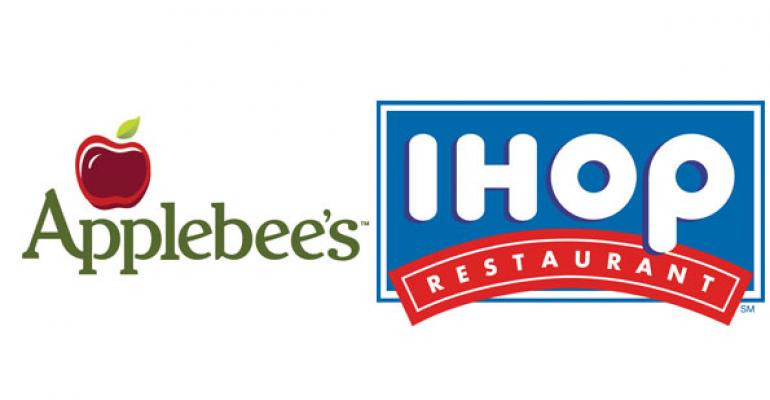Applebee’s parent DineEquity Inc. is working on strategies to drive traffic by targeting specific consumers and the emotional connection they have with the casual-dining brand, the company said after reporting second-quarter results on Tuesday.
At sister brand IHOP, revitalization efforts are continuing to drive momentum.
RELATED
• Applebee's debuts first location-specific menu item
• Applebee’s teams with Flixster to help moviegoers find restaurants
• DineEquity 3Q net income declines 69%
The family-dining chain recorded a domestic systemwide same-store sales increase of 3.2 percent for the June 30-ended quarter, which the company said reflected positive sales across all dayparts.
It was the fifth consecutive quarter of same-store sales increases for the 1,625-unit family-dining chain following a redesign of the menu last year that prompted guests to buy more appetizers and higher-priced dishes. The chain also tweaked its advertising and operational execution to enhance the overall value proposition.
As a result, DineEquity upgraded its outlook for IHOP, saying same-store sales for the year will likely increase between 1 percent and 2.5 percent. Previously, the company expected IHOP’s same-store sales would rise between 0.5 percent and 2 percent for the year.
Domestic same-store sales for Applebee’s Neighborhood Grill & Bar, however, rose a more modest 0.6 percent, which largely reflected an increase in average check that offset a “slight” decline in traffic, said Julia Stewart, DineEquity’s chair and chief executive.
The chain’s positive sales outperformed the casual-dining industry as a whole, which has struggled with negative sales for years. But Stewart said, “We have more to do to restore consistent and sustainable positive performance.”
Driving consistent increases in traffic remains a priority, and the company continues to work on strategies to “push the reset button,” she said.
After conducting in-depth research on Applebee’s’ target audience, Stewart said the company has been working on key strategies, including improving in-restaurant speed, defining daypart strategies for growth, building guest loyalty and “defining the Applebee’s of the future to adapt to the new marketplace,” Stewart said.
The research has given company officials a better picture of how to target specific consumers, not necessarily by income levels or demographics, but by what they think about restaurants and casual dining in general, said Stewart.
“It’s less about age and generational. It’s more about an emotional attune to how they think about restaurants and casual dining and us, in particular, and what it will take to get them to come more often,” said Stewart. “They’re very clear about what they want us to do differently, and we have to find our sweet spot, especially in competing against fast casual.”
Making Applebee's more relevant
Improving the bar business is one example of an area where Applebee’s could be made “more contemporary and more relevant,” Stewart said, such as offering more craft beers.
Targeted guests have also been “loud and clear” about wanting to customize their experience as much as possible, Stewart said. As a result, DineEquity is developing a loyalty program for both Applebee’s and IHOP that will attempt to make the customer experience unique for each guest, said Stewart.
That’s still a work in progress, she added. “The biggest single thing we have to work on is the algorithm.”
Stewart said the company is also still working on the test of a fast-casual service variation at lunch, but so far giving the option of ordering at the counter has been “confusing and not working for our consumer base,” said Stewart.
Part of the problem is that the casual-dining model has spent decades training guests to walk to a hostess stand and be directed to a table. Asking guests to relearn one aspect of the ordering process alone doesn’t appear to work, she said.
“We try to do one thing differently, but the truth is the entire environment at lunch has to be different,” she said. “We think there are different ways to bring it to life at different dayparts.”
Applebee’s is continuing its roll out of table-top tablets, allowing guests to order and pay with the swipe of a credit card and eliminating what Stewart described as the “No. 1 pain point” of waiting for a server to bring the check. About half of the chain’s 2,008 units will have the technology by the end of the year, she said.
For the second quarter, DineEquity said net income rose 13 percent to $19.2 million, or $1 per share, compared with $16.9 million, or 87 cents per share, a year ago.
Revenue increased 1.5 percent to $160.5 million, compared with $158.1 million the prior year.
In addition, Glendale, Calif.-based DineEquity announced that it intends to refinance its 3.75-percent senior secured credit facility and its 9.5-percent senior notes, but officials declined to offer any details of the plan during the call with analysts Tuesday. As of the end of the second quarter, DineEquity’s senior secured credit facility and senior notes were about $465 million and $761 million, respectively.
Contact Lisa Jennings at [email protected]
Follow her on Twitter @livetodineout

